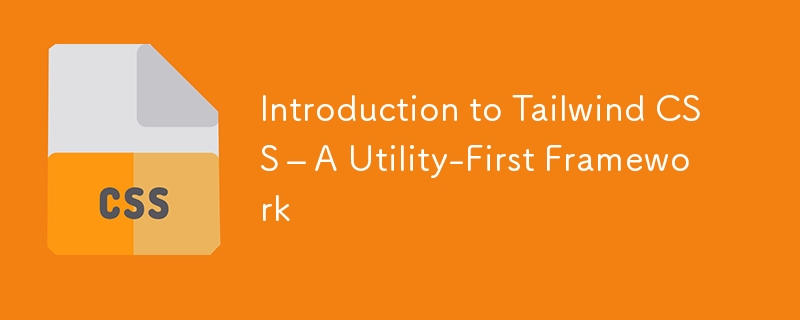Introduction to Tailwind CSS – A Utility-First Framework

Introduction to Tailwind CSS – A Utility-First Framework
In this Article, we will explore Tailwind CSS, a popular utility-first CSS framework that allows you to build modern websites quickly without writing custom CSS. Unlike traditional CSS frameworks, Tailwind doesn’t come with pre-designed components but instead provides utility classes that let you style your elements directly in your HTML.
1. What is Tailwind CSS?
Tailwind CSS is a utility-first framework, meaning it focuses on giving you small, reusable classes for applying styles. Instead of writing custom styles, you use predefined classes to build layouts and components.
Example:
<button class="bg-blue-500 text-white font-bold py-2 px-4 rounded">
Click Me
</button>
Here, you can see multiple utility classes being used:
- bg-blue-500: Sets the background color.
- text-white: Applies white text.
- font-bold: Makes the text bold.
- py-2 px-4: Adds padding vertically and horizontally.
- rounded: Rounds the button corners.
2. Why Tailwind?
Tailwind’s approach is different from traditional CSS frameworks like Bootstrap. Rather than providing pre-built components, it encourages developers to create custom designs by composing utility classes. This leads to a more flexible and customizable workflow.
Advantages:
- Faster Development: No need to write custom CSS.
- Design Consistency: Utilities allow for design consistency without duplicating styles.
- No Dead CSS: Unused styles can be easily purged in production.
Disadvantages:
- Class-heavy HTML: Your HTML might become packed with classes, which can be overwhelming at first.
- Learning Curve: Requires learning Tailwind-specific utilities.
3. Setting Up Tailwind CSS
To start using Tailwind CSS, you can either use the CDN (for simple projects) or install it via npm (for more complex workflows).
CDN Setup:
You can quickly start using Tailwind by adding the following link in your HTML file:
<link href="https://cdn.jsdelivr.net/npm/tailwindcss@2.2.19/dist/tailwind.min.css" rel="stylesheet">
npm Setup (for larger projects):
If you’re working on a larger project, you may want to install Tailwind CSS via npm:
npm install tailwindcss
Once installed, you can generate the tailwind.config.js file to customize your setup and integrate it with your build process.
Conclusion
Tailwind CSS is a game-changer for developers looking for a streamlined way to create custom designs quickly. It allows you to build responsive, flexible, and consistent websites by composing small utility classes directly in your HTML.
follow me on LinkedIn
Ridoy Hasan
The above is the detailed content of Introduction to Tailwind CSS – A Utility-First Framework. For more information, please follow other related articles on the PHP Chinese website!

Hot AI Tools

Undresser.AI Undress
AI-powered app for creating realistic nude photos

AI Clothes Remover
Online AI tool for removing clothes from photos.

Undress AI Tool
Undress images for free

Clothoff.io
AI clothes remover

Video Face Swap
Swap faces in any video effortlessly with our completely free AI face swap tool!

Hot Article

Hot Tools

Notepad++7.3.1
Easy-to-use and free code editor

SublimeText3 Chinese version
Chinese version, very easy to use

Zend Studio 13.0.1
Powerful PHP integrated development environment

Dreamweaver CS6
Visual web development tools

SublimeText3 Mac version
God-level code editing software (SublimeText3)

Hot Topics
 Vue 3
Apr 02, 2025 pm 06:32 PM
Vue 3
Apr 02, 2025 pm 06:32 PM
It's out! Congrats to the Vue team for getting it done, I know it was a massive effort and a long time coming. All new docs, as well.
 Can you get valid CSS property values from the browser?
Apr 02, 2025 pm 06:17 PM
Can you get valid CSS property values from the browser?
Apr 02, 2025 pm 06:17 PM
I had someone write in with this very legit question. Lea just blogged about how you can get valid CSS properties themselves from the browser. That's like this.
 A bit on ci/cd
Apr 02, 2025 pm 06:21 PM
A bit on ci/cd
Apr 02, 2025 pm 06:21 PM
I'd say "website" fits better than "mobile app" but I like this framing from Max Lynch:
 Using Markdown and Localization in the WordPress Block Editor
Apr 02, 2025 am 04:27 AM
Using Markdown and Localization in the WordPress Block Editor
Apr 02, 2025 am 04:27 AM
If we need to show documentation to the user directly in the WordPress editor, what is the best way to do it?
 Stacked Cards with Sticky Positioning and a Dash of Sass
Apr 03, 2025 am 10:30 AM
Stacked Cards with Sticky Positioning and a Dash of Sass
Apr 03, 2025 am 10:30 AM
The other day, I spotted this particularly lovely bit from Corey Ginnivan’s website where a collection of cards stack on top of one another as you scroll.
 Comparing Browsers for Responsive Design
Apr 02, 2025 pm 06:25 PM
Comparing Browsers for Responsive Design
Apr 02, 2025 pm 06:25 PM
There are a number of these desktop apps where the goal is showing your site at different dimensions all at the same time. So you can, for example, be writing
 How to Use CSS Grid for Sticky Headers and Footers
Apr 02, 2025 pm 06:29 PM
How to Use CSS Grid for Sticky Headers and Footers
Apr 02, 2025 pm 06:29 PM
CSS Grid is a collection of properties designed to make layout easier than it’s ever been. Like anything, there's a bit of a learning curve, but Grid is
 Google Fonts Variable Fonts
Apr 09, 2025 am 10:42 AM
Google Fonts Variable Fonts
Apr 09, 2025 am 10:42 AM
I see Google Fonts rolled out a new design (Tweet). Compared to the last big redesign, this feels much more iterative. I can barely tell the difference






